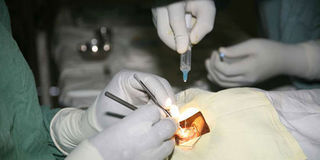Many face cloudy future over cataracts

A patient undergoes eye surgery. About 14,500 new cases of cataracts are registered every year and 140,000 Kenyans could be blinded by cataracts by 2020. PHOTO | FILE | NATION MEDIA GROUP
What you need to know:
- More specialist training and rational deployment of health workers will provide better eye health services.
- Public health education is the cornerstone of prevention and management. This can be achieved by training community health volunteers.
School days should be a cheerful time for nine-year-olds. For Baraka Lakoria, despite seeking learning with diligence, every morning brought misery due to the unending haziness in his eyes. It didn’t help that he sat under the teacher’s nose.
Craning his neck to copy notes from the blackboard became frustrating as the cloudiness in his eyes increased and he became reliant on his deskmate’s notes.
Most times, he was not fast enough. He became introverted and fearful to actively participate in class and was later diagnosed with cataracts.
The poor vision may have slowed him down, but after a life-saving surgery, he became an unstoppable hero, more attentive in class and a rising star in the field. The eye surgery had brought out his undiscovered gift as an agile footballer.
BLINDNESS
A cataract is the clouding of the lens in the eye, which prevents clear vision. Sadly, just like in adults, cataracts is the leading cause of blindness in children and affects their optimal growth, and development.
Preventing blindness is in line with Sustainable Development Goals one and three that seek to end poverty and promote health and well-being respectively.
The World Health Organisation says that one out of every two cases of blindness globally is due to cataracts, yet it is treatable by a simple 20 to 30-minute operation.
However, at about Sh5,000 per eye, this surgery is out of reach for most patients, especially in rural areas. The Ministry of Health says Kenya has about 120 eye doctors, half of them in Nairobi.
POVERTY
About 14,500 new cases of cataracts are registered every year and 140,000 Kenyans could be blinded by cataracts by 2020 if prevention, treatment and management guidelines are not implemented.
In a 2008 study, Prof Wanjiku Mathenge and colleagues in three developing countries, Bangladesh, Kenya, and the Philippines, showed that visual impairments by cataracts led to reduced employment opportunities.
They called for increased provision of cataract surgery to poor people. More specialist training and rational deployment of health workers will provide better eye health services.
EXPERTS
Fred Hollows Foundation is committed to ending avoidable blindness by providing training equipment, equipping the skills and IT lab for eye health students at the Kenya Medical Training College. Through the Health ministry, we supplement the treatment cost.
Kenya needs 100 more ophthalmologists, and 370 mid-level eye health workers. An innovative scheme where clinical officers get specialist training in cataract surgery has been adopted. There is a need to restore infrastructure and to deploy skilled technicians.
Public health education is the cornerstone of prevention and management. This can be achieved by training community health volunteers.
We need to work together to bring the eye health resources for more impact, greater sustainability and value to all.
Ms Ohuma is the country manager, Fred Hollows Foundation, Kenya. [email protected]




